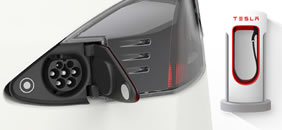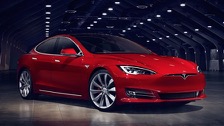Price from (last known)
£0
| Availability |
Not available to order |
| Available to order from |
July 2015 |
| Available to order until |
April 2016 |
| Annual VED |
£0 |
| Congestion Charge |
£0 |
| Insurance Group |
N/A |
Price shown is the last known On The Road price: it includes VAT, first year VED, vehicle first registration fee, number plates and delivery.
Real Range Estimation between 185 - 365 mi
| City - Cold Weather * |
250 mi |
| Highway - Cold Weather * |
185 mi |
| Combined - Cold Weather * |
215 mi |
| City - Mild Weather * |
365 mi |
| Highway - Mild Weather * |
235 mi |
| Combined - Mild Weather * |
290 mi |
Indication of real-world range in several situations. Cold weather: 'worst-case' based on -10°C and use of heating. Mild weather: 'best-case' based on 23°C and no use of A/C. For 'Highway' figures a constant speed of 70 mph is assumed. The actual range will depend on speed, style of driving, weather and route conditions.
Battery
| Nominal Capacity |
90.0 kWh |
| Battery Type |
Lithium-ion |
| Number of Cells |
No Data |
| Architecture |
400 V |
| Warranty Period |
No Data |
| Warranty Mileage |
No Data |
| Useable Capacity* |
85.5 kWh |
| Cathode Material |
No Data |
| Pack Configuration |
No Data |
| Nominal Voltage |
No Data |
| Form Factor |
No Data |
| Name / Reference |
No Data |
Charging
Home / Destination
| Charge Port |
Type 2 |
| Port Location |
Left Side - Rear |
| Charge Power † |
11 kW AC |
| Charge Time (0->255 mi) † |
9h15m |
| Charge Speed † |
28 mph |
Rapid Charging
| Fastcharge Port |
Supercharger |
| FC Port Location |
Left Side - Rear |
| Fastcharge Power (max) |
120 kW DC |
| Fastcharge Power (10-80%) |
90 kW DC |
| Fastcharge Time (25->204 mi) |
42 min |
| Fastcharge Speed |
250 mph |
| Autocharge Supported |
No |
Plug & Charge
| Plug & Charge Supported |
No |
† This can only be achieved using a 3-phase grid connection. The majority of homes and charge points do not have this connection. In practice charge power will often be 7.4 kW, allowing for a charge time of 13h45m and a charge speed of 19 mph.
Bidirectional Charging (V2X / BPT)
Vehicle-to-Load (V2L)
| V2L Supported |
No |
| Max. Output Power |
- |
| Exterior Outlet(s) |
- |
| Interior Outlet(s) |
- |
Vehicle-to-Home (V2H)
| V2H via AC Supported |
No |
| Max. Output Power |
- |
| V2H via DC Supported |
No |
| Max. Output Power |
- |
Vehicle-to-Grid (V2G)
| V2G via AC Supported |
No |
| Max. Output Power |
- |
| V2G via DC Supported |
No |
| Max. Output Power |
- |
Energy Consumption
EVDB Real Range
| Range * |
255 mi |
| Vehicle Consumption * |
335 Wh/mi |
| CO2 Emissions |
0 g/km |
| Vehicle Fuel Equivalent * |
121 mpg |
NEDC Ratings
| Range |
314 mi |
| Rated Consumption |
No Data |
| Vehicle Consumption |
272 Wh/mi |
| CO2 Emissions |
0 g/km |
| Rated Fuel Equivalent |
No Data |
| Vehicle Fuel Equivalent |
148 mpg |
Rated = official figures as published by manufacturer. Rated consumption and fuel equivalency figures include charging losses.
Vehicle = calculated battery energy consumption used by the vehicle for propulsion and on-board systems.
NOTE: The fuel equivalency figures are shown in IMPERIAL MPG. Figures in US MPG will differ significantly.
Real Energy Consumption Estimation between 234 - 462 Wh/mi
| City - Cold Weather * |
342 Wh/mi |
| Highway - Cold Weather * |
462 Wh/mi |
| Combined - Cold Weather * |
398 Wh/mi |
| City - Mild Weather * |
234 Wh/mi |
| Highway - Mild Weather * |
364 Wh/mi |
| Combined - Mild Weather * |
295 Wh/mi |
Indication of real-world energy use in several situations. Cold weather: 'worst-case' based on -10°C and use of heating. Mild weather: 'best-case' based on 23°C and no use of A/C. For 'Highway' figures a constant speed of 70 mph is assumed. The energy use will depend on speed, style of driving, climate and route conditions.
Safety (Euro NCAP)
| Safety Rating |
|
| Adult Occupant |
82% |
| Child Occupant |
77% |
| Rating Year |
2014 |
| Vulnerable Road Users |
66% |
| Safety Assist |
71% |
For more details on the safety rating of this vehicle, visit
euroncap.com
Dimensions and Weight
| Length |
4970 mm |
| Width |
1964 mm |
| Width with mirrors |
No Data |
| Height |
1445 mm |
| Wheelbase |
2960 mm |
| Weight Unladen (EU) |
2262 kg |
| Gross Vehicle Weight (GVWR) |
2670 kg |
| Max. Payload |
483 kg |
| Cargo Volume |
895 L |
| Cargo Volume Max |
1792 L |
| Cargo Volume Frunk |
No Data |
| Roof Load |
No Data |
| Tow Hitch Possible |
No Data |
| Towing Weight Unbraked |
No Data |
| Towing Weight Braked |
No Data |
| Vertical Load Max |
No Data |
Miscellaneous
| Seats |
5 people |
| Isofix |
Yes, 2 seats |
| Turning Circle |
12.4 m |
| Platform |
TESLA S/X |
| EV Dedicated Platform |
Yes |
| Car Body |
Liftback Saloon |
| Segment |
Luxury |
| Roof Rails |
No Data |
| Heat pump (HP) |
No Data |
| HP Standard Equipment |
No Data |
* = estimated value. Average energy consumption and range based on moderate drive style and climate. Real-life values may differ significantly. Pricing information might not be actual for some regions. No rights can be derived from the information on this site.



 Tesla Model S P90D
Tesla Model S P90D